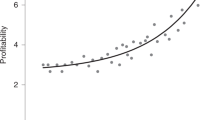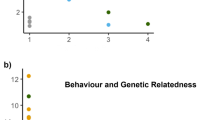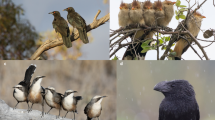Abstract
In the few species of birds in which males form display partnerships to attract females, one male secures most or all of the copulations1,2. This leads to the question of why subordinate males help in the absence of observable reproductive benefits. Hamilton's concept of kin selection3, whereby individuals can benefit indirectly by helping a relative, was a crucial breakthrough for understanding apparently altruistic systems. However in the only direct test of kin selection in coordinated display partnerships, partners were unrelated1, discounting kin selection as an explanation for the evolution of cooperation. Here I show, using genetic measures of relatedness and reproductive success, that kin selection can explain the evolution of cooperative courtship in wild turkeys. Subordinate (helper) males do not themselves reproduce, but their indirect fitness as calculated by Hamilton's rule3,4 more than offsets the cost of helping. This result confirms a textbook example of kin selection2 that until now has been controversial5 and also extends recent findings6,7,8 of male relatedness on avian leks by quantifying the kin-selected benefits gained by non-reproducing males.
This is a preview of subscription content, access via your institution
Access options
Subscribe to this journal
Receive 51 print issues and online access
$199.00 per year
only $3.90 per issue
Buy this article
- Purchase on Springer Link
- Instant access to full article PDF
Prices may be subject to local taxes which are calculated during checkout


Similar content being viewed by others
References
McDonald, D. B. & Potts, W. K. Cooperative display and relatedness among males in a lek-mating bird. Science 266, 1030–1032 (1994)
Watts, C. R. & Stokes, A. W. The social order of turkeys. Sci. Am. 224, 112–118 (1971)
Hamilton, W. D. The genetical theory of social behavior. I and II. J. Theor. Biol. 7, 1–52 (1964)
Lucas, J. R., Creel, S. R. & Waser, P. M. How to measure inclusive fitness, revisited. Anim. Behav. 51, 225–228 (1996)
Balph, D. F., Innes, G. S. & Balph, M. H. Kin selection in turkeys: a critical assessment. Auk 97, 854–860 (1980)
Höglund, J., Alatalo, R. V., Lundberg, A., Rintamaki, P. K. & Lindell, J. Microsatellite markers reveal the potential for kin selection on black grouse leks. Proc. R. Soc. Lond. B 266, 813–816 (1999)
Petrie, M., Krupa, A. & Burke, T. Peacocks lek with relatives even in the absence of social and environmental cues. Nature 401, 155–157 (1999)
Shorey, L., Piertney, S., Stone, J. & Höglund, J. Fine-scale genetic structure on Manacus manacus leks. Nature 408, 352–353 (2000)
Brown, J. L. Helping and Communal Breeding in Birds (Princeton Univ. Press, Princeton, 1987)
Emlen, S. T. Benefits, constraints and the evolution of the family. Trends Ecol. Evol. 9, 282–285 (1994)
Clutton-Brock, T. H. Breeding together—kin selection and mutualism in cooperative vertebrates. Science 296, 69–72 (2002)
Griffin, A. S. & West, S. A. Kin descrimination and the benefit of helping in cooperatively breeding vertebrates. Science 302, 634–636 (2003)
Kokko, H. & Linström, J. Kin selection and the evolution of leks: whose success do young males maximize? Proc. R. Soc. Lond. B 263, 919–923 (1996)
Höglund, J. Lek-kin in birds—provoking theory and surprising new results. Ann. Zool. Fenn. 40, 249–253 (2003)
Wilson, E. O. Sociobiology: the New Synthesis (Harvard Univ. Press, Boston, Massachusetts, 1975)
Goodenough, J., McGuire, B. & Wallace, R. A. Perspectives on Animal Behavior 2nd edn (Wiley, New York, 2001)
Blouin, M. S. DNA-based methods for pedigree reconstruction and kinship analysis in natural populations. Trends Ecol. Evol. 18, 503–511 (2003)
Buchholz, R. Female choice, parasite load, and male ornamentation in wild turkeys. Anim. Behav. 50, 929–943 (1995)
Buchholz, R. Male dominance and variation in fleshy head ornamention in wild turkeys. J. Avian Biol. 28, 223–230 (1997)
Lank, D. B. et al. High frequency of polyandry in a lek mating system. Behav. Ecol. 13, 209–215 (2002)
Healy, W. M. The Wild Turkey: Biology and Management (ed. Dickson, J. D.) 46–65 (Stackpole, Mechanicsburg, Pennsylvania, 1992)
Donoghue, A. M., Sonstegard, T. S., King, L. M., Smith, E. J. & Burt, D. W. Turkey sperm mobility influences paternity in the context of competitive fertilization. Biol. Reprod. 61, 422–427 (1999)
Reed, K. M., Roberts, M. C., Murtaugh, J., Beattie, C. W. & Alexander, L. J. Eight new dinucleotide microsatellite loci in turkey (Meleagris gallopavo). Anim. Genet. 31, 140 (2000)
Mock, K. E., Theimer, T. C., Rhodes, O. E., Greenberg, D. L. & Keim, P. Genetic variation across the historical range of the wild turkey (Meleagris gallopavo). Mol. Ecol. 11, 643–657 (2002)
Raymond, M. & Rousset, F. GENEPOP (version 3.1b). An updated version of GENEPOP version 1.2: population genetics software for exact tests and ecumenicism. J. Hered. 86, 248–249 (1997)
Queller, D. C. & Goodnight, K. F. Estimating relatedness using genetic markers. Evolution 43, 258–275 (1989)
Marshall, T. C., Slate, J., Kruuk, L. E. B. & Pemberton, J. M. Statistical confidence for likelihood-based paternity inference in natural populations. Mol. Ecol. 7, 639–655 (1998)
Acknowledgements
I thank E. DuVal, E. Lacey and especially W. Koenig and M. Hauber for comments on the manuscript; J. Dickinson, S. Beissinger, B. Jones, B. Slikas and N. Johnson for training and discussion; B. Davis, A. Hsieh, F. Aguillar, C. Miller, J. Leyhe, R. Orben, L. Robinson, M. Nguyen, B. Loui, M. Nasiri and C. Chu and others for field and laboratory assistance; and P. Kephart for research access to Rana Creek Ranch. My research was funded by an NSF graduate fellowship and dissertation improvement grant, as well as the Animal Behavior Society, American Ornithologists' Union, Sigma Xi, and support from both Integrative Biology and the Museum of Vertebrate Zoology at the University of California, Berkeley.
Author information
Authors and Affiliations
Corresponding author
Ethics declarations
Competing interests
The author declares that he has no competing financial interests.
Supplementary information
Supplementary Table 1
This table provides individual histories of coalitions and solitary males. (DOC 34 kb)
Supplementary Table 2
This table provides details of the microsatellite loci used, the allelic diversity found in the study population, and the PCR reaction conditions. (DOC 28 kb)
Supplementary Table 3
This table details the parameters used in the paternity analysis. (DOC 22 kb)
Rights and permissions
About this article
Cite this article
Krakauer, A. Kin selection and cooperative courtship in wild turkeys. Nature 434, 69–72 (2005). https://doi.org/10.1038/nature03325
Received:
Accepted:
Issue Date:
DOI: https://doi.org/10.1038/nature03325
This article is cited by
-
Sex-specific morphs: the genetics and evolution of intra-sexual variation
Nature Reviews Genetics (2023)
-
Tests of reproductive skew theory: a review and prospectus
Evolutionary Ecology (2023)
-
Ordinaries 13: apparent spite & apparent altruism
Journal of Bioeconomics (2023)
-
Should I stay or should I go now: dispersal decisions and reproductive success in male white-faced capuchins (Cebus imitator)
Behavioral Ecology and Sociobiology (2022)
-
Male–male associations in spotted bowerbirds (Ptilonorhynchus maculatus) exhibit attributes of courtship coalitions
Behavioral Ecology and Sociobiology (2022)
Comments
By submitting a comment you agree to abide by our Terms and Community Guidelines. If you find something abusive or that does not comply with our terms or guidelines please flag it as inappropriate.



